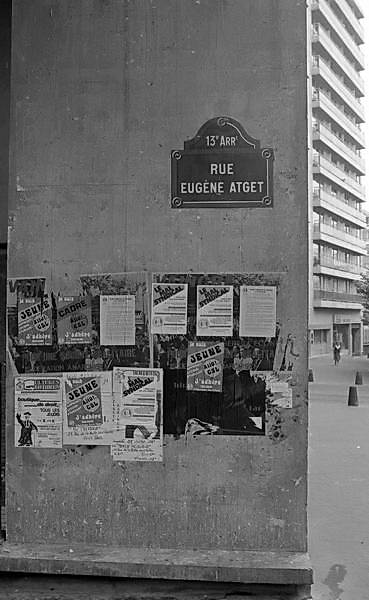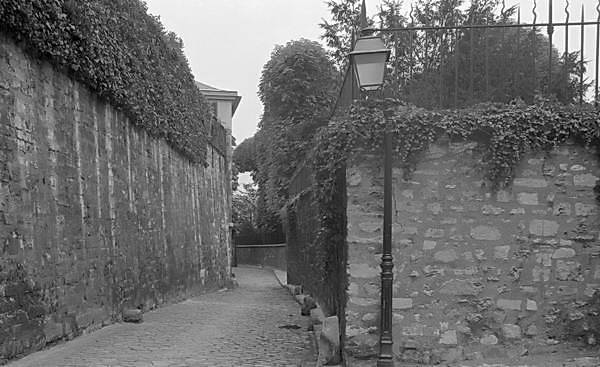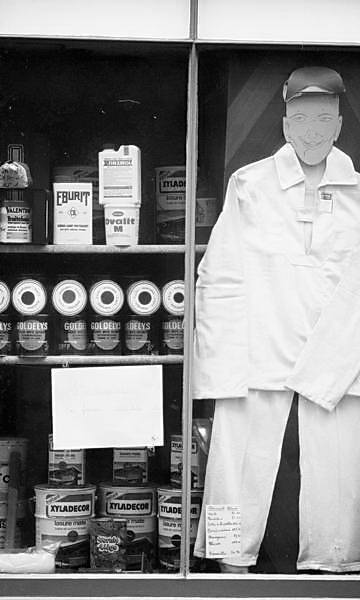The 28 pictures that make up ‘Set 1’ of Paris Revisited included many of the favourite pictures that I took there in 1984, but there are also quite a few others that appeal to me, or that I found of particular interest for various reasons. It was good, for example, to find that Eugene Atget had a street named after him:

though I’m fairly sure he would not have appreciated the architecture. Almost certainly the buildings that were demolished to make way for it were more to his taste – and probably among the many in the area that he photographed. This picture and the others in this post are in Paris Revisited – Set 2
One scene that was virtually unchanged since he photographed it was in rue Berton in the 16th arrondissement, and it is one of the few pictures where I consciously copied one of his works.

Of course there are differences. One is in the aspect ratio – his pictures are much more square than the 1.5:1 of 35mm cameras. Using the V750 scanner with the supplied film holder and Epson software which auto-detects the frame actually crops the 35mm neg to higher aspect ratio of around 1.63:1 making the difference more pronounced.

Most of these images from Paris were taken using an Olympus OM4 camera which had come out in 1983, and using the Olympus 35mm shift lens. This gave some of the control over perspective that is available using the rising and falling front and left-right movement available in many large format cameras, but lacked the tilt and swing of some of them. The greater depth of field on the smaller format largely made this unnecessary so far as getting sufficient depth of field was concerned if your aim was to achieve overall sharpness in a image.
It was quite a bulky lens compared with the non-shift 35mm lens, partly because of the mechanism allowing the lens to shift around 10mm left or right and 12mm up and down between the lens and the camera. But it is also larger to give a wider image circle at the film plane. A normal 35mm lens has to produce a sharp image across the diagonal of the format – around 43 mm. To allow the lens to move 10mm to left or right, the PC lens needs to have an image circle of around 61mm, which also allowed a maximum rise of 12mm and fall of 13mm. You could also combine smaller amounts of sideways and up and down movement – and the lens design ensured that these kept within that image circle.
The larger image circle meant that if you didn’t use the shifts you were working in the central area of the lens, and gave the lens a really excellent performance – and it remained pretty good even a maximum shift.
As with the movements on large format cameras, perhaps the most common and certainly the most obvious use is in photographing buildings. To avoid converging verticals you need to keep the camera level and not to tilt it, but to do this from ground level without a rising front, you have to move back so that the base of the building is at the middle of the frame. With a rising front or a shift lens you can move in closer and eliminate all or most of the foreground.
Of course now that images are digital (or scanned) you can tilt the camera and then straighten up the image in Photoshop but this does involve some extrapolation and thus loss of quality in the result and is best kept to a minimum.
But the shift lens really introduces a different dimension to photographic composition, meaning you can to some extent separate perspective from viewpoint. Although text-books draw diagrams and show example photographs I think it really is something you can only really appreciate by working with it day in and day out.
There were some downsides the the lens. Firstly it was rather expensive, even like mine when bought second-hand. But because of the sliding mechanism it was a purely manual lens without the automatic stopping down of the iris we usually take for granted. So when using it the first thing was to stand in the place you wanted to take the picture from, then point the camera and push the lens across or up or down as required to adjust the perspective. As usual you would do this with the lens wide open, and it would stay wide open whatever aperture you set on the aperture ring. For metering and taking the picture you then held down a small button on the lens which stopped it down to the value set by the aperture ring, and when you had set the shutter speed (or viewed that chosen by the camera on an auto setting) you kept holding that button down while making the exposure.
It soon became second nature, particularly since for some years I probably took around 90% of my pictures with this lens. So much so that even now I sometimes find myself trying to slide the lens on my Nikon across or feeling for that button to hold down when I’m taking pictures. And I’m sometimes more than a little disappointed to find that these lenses just won’t shift!
[Nikon do make PC lenses, including the wide angle 24mm f/3.5D ED PC-E Nikkor as well as a 45mm and 85mm, none of which I’d really find suitable for general photography. Unlike the Olympus lens they only shift in one dimension – you can have rise/fall or, by rotating the lens by 90 degrees left/right but not a combination of both. They do however have a tilt, making them more versatile for specialised use.]
Apology
Attentive readers of this blog may have noticed that my previous post, Parc de St Cloud 1984 was about the same set of pictures as an earlier post with the same title, Parc de St Cloud 1984 but at least I wrote something a little different about them second time!